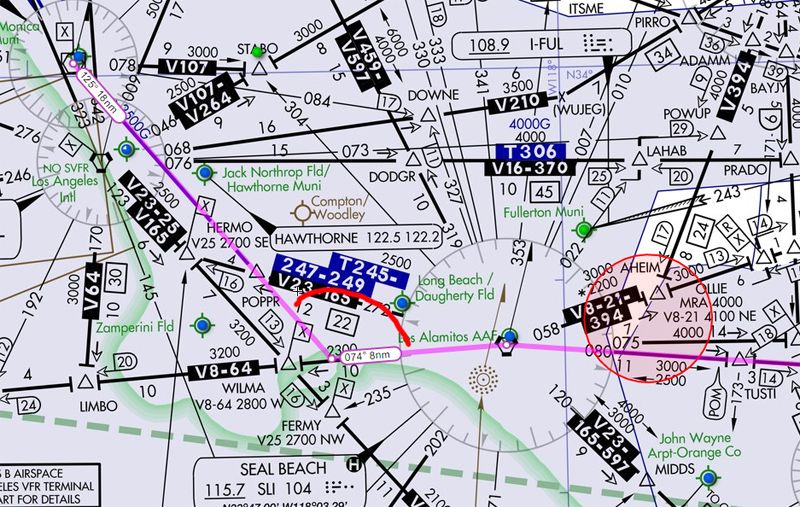SMO tp CRQ tec/comments/help
Posted: Fri Jan 15, 2016 11:09 am
I did something to place a bit more challenge on myself than usual. After KS's suggestion in another post I decided to fly SMO to CRQ. All of this was hand flown, in a fast aircraft (Lancair Legacy),and +/1 100 ft altitude, and the kicker for me, (I'm a child of the magenta!), no GPS!
The TEC route is this: SMO SMO125 V64 V363 DANAH V23 OCN
The short story is that except for some bizarre wind shift caused by my weather engine I was able to keep the +/- 100 ft the entire trip at 250 ktas. Most everything went pretty well. But I have a few questions/things I could do better.
With a GPS, there is turn prediction, and I'm sort of used to this. With my ATC background I thought I had a good handle on when to turn but I'm usually a bit off. Is there a rule of thumb for certain airspeeds on when to turn to the next course? For instance, the turn from the SMO125R to intercept V64... it's not a sharp turn, but a decent angle of course change required. At 250 kts I think I turned about 16 miles from SMO (the leg is about 18 miles). I was too early on that turn, and had to fly more SE to get on V64. If the turn required was 90 degrees I typically use the same rule I use when vectoring aircraft to final approach course. 1/GS - so in my case 2.5 miles if I was doing 250 kts (ground speed assuming here). But I've found that's too early sometimes to actually join a new course. When I'm vectoring, the acft joins off a 20 or 30 (45 if helicopter) degree course intercept. But in a case where I need to make a 90 degree turn I'm trying to find a smooth turn to glide right onto the new course. How to do this?

Another thing... nearing OCN the controller told me "depart OCN heading 080." Does this mean I should treat OCN as a fly over fix? Or should I turn when I normally would (before the navaid), to a 080 heading? You might ask "how does a controller not know this!" Because we never use that technique where I work, and I don't know what the pilots would do.
Overall the flight when really well, I finished it off with a fast flown ILS Ry 24 at Palomar (I wussed out and should have done the LOC!)
The TEC route is this: SMO SMO125 V64 V363 DANAH V23 OCN
The short story is that except for some bizarre wind shift caused by my weather engine I was able to keep the +/- 100 ft the entire trip at 250 ktas. Most everything went pretty well. But I have a few questions/things I could do better.
With a GPS, there is turn prediction, and I'm sort of used to this. With my ATC background I thought I had a good handle on when to turn but I'm usually a bit off. Is there a rule of thumb for certain airspeeds on when to turn to the next course? For instance, the turn from the SMO125R to intercept V64... it's not a sharp turn, but a decent angle of course change required. At 250 kts I think I turned about 16 miles from SMO (the leg is about 18 miles). I was too early on that turn, and had to fly more SE to get on V64. If the turn required was 90 degrees I typically use the same rule I use when vectoring aircraft to final approach course. 1/GS - so in my case 2.5 miles if I was doing 250 kts (ground speed assuming here). But I've found that's too early sometimes to actually join a new course. When I'm vectoring, the acft joins off a 20 or 30 (45 if helicopter) degree course intercept. But in a case where I need to make a 90 degree turn I'm trying to find a smooth turn to glide right onto the new course. How to do this?

Another thing... nearing OCN the controller told me "depart OCN heading 080." Does this mean I should treat OCN as a fly over fix? Or should I turn when I normally would (before the navaid), to a 080 heading? You might ask "how does a controller not know this!" Because we never use that technique where I work, and I don't know what the pilots would do.
Overall the flight when really well, I finished it off with a fast flown ILS Ry 24 at Palomar (I wussed out and should have done the LOC!)